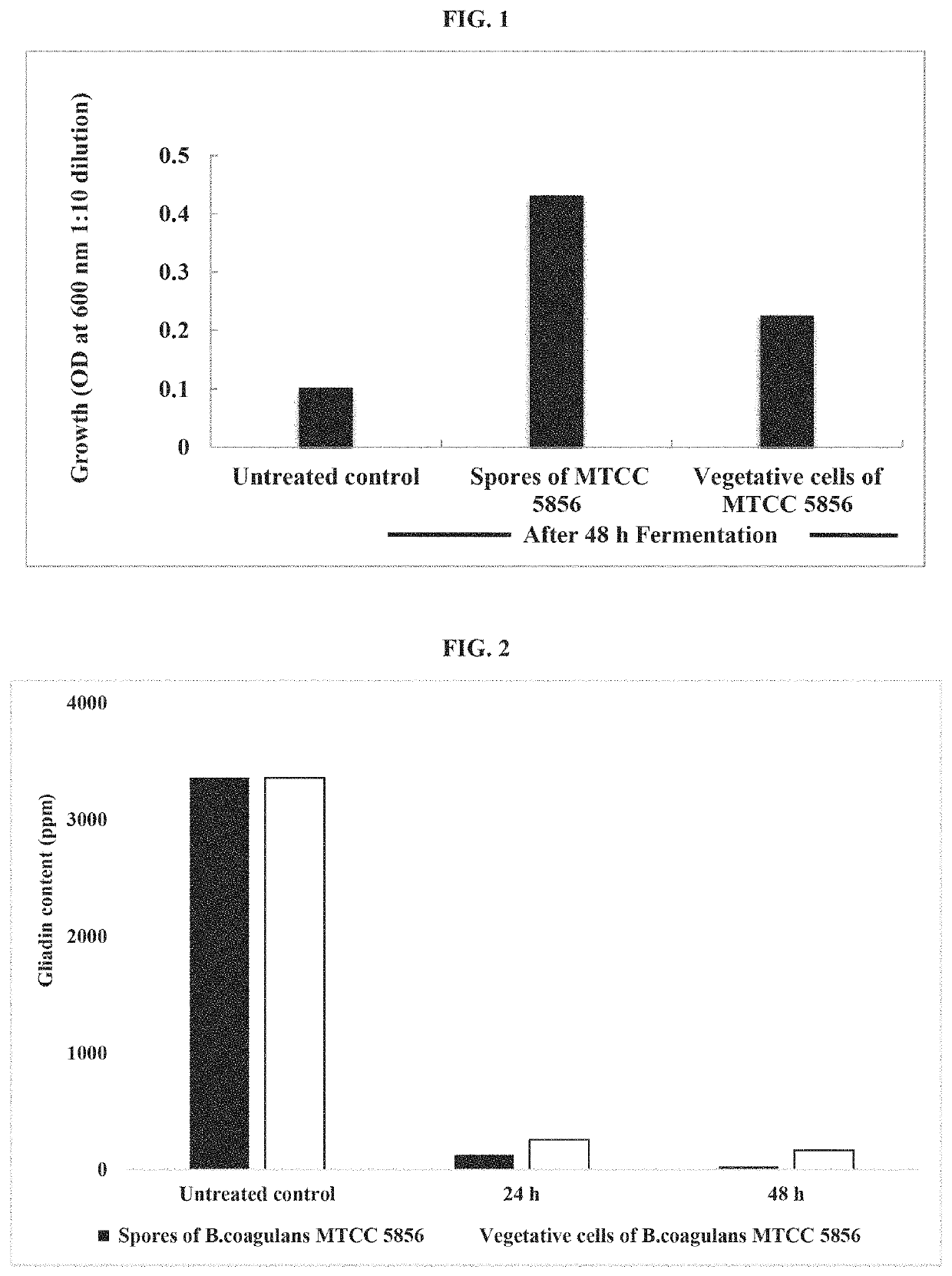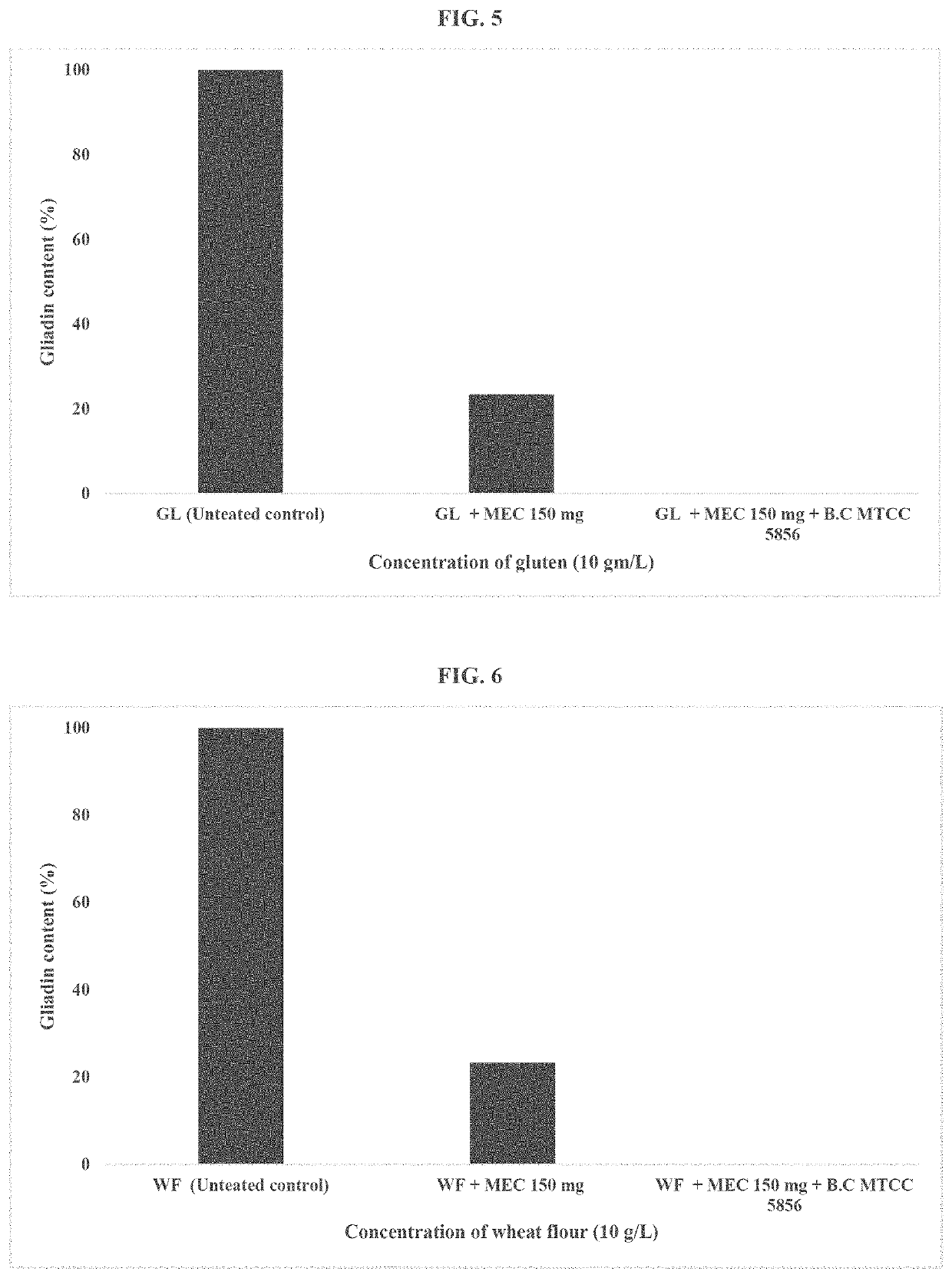Method and composition for therapeutic management of gluten intolerance
a technology for gluten intolerance and therapeutic management, applied in the field of probiotic compositions, can solve the problems of strain specificity, inability to generalise amongst patients, and failure to thriv
- Summary
- Abstract
- Description
- Claims
- Application Information
AI Technical Summary
Benefits of technology
Problems solved by technology
Method used
Image
Examples
example 1
Utilization of Gluten (GL) by Bacillus Coagulans MTCC 5856 in Media
[0030]Methodology
[0031]B. coagulans MTCC 5856 was grown in media (Compositions: 5 g / l Peptic digest of animal tissue, 5 g / l Yeast extract, 2 g / l Dextrose, 0.5 g / l Dipotassium phosphate, 0.5 g / l Monopotassium phosphate, 0.3 g / l Magnesium sulfate and 0.3 g / l sodium chloride, 0.1 g / l Manganese sulphate pH 6.5). After 48 h of incubation, a seed of 250 ml was washed with saline twice and final pallet was added with 10 ml of saline and transferred to fresh sterile media.
[0032]After 24 h of incubation, the seed was transferred to fresh sterile media (Composition: 2.5 to 10 g / l gluten from wheat (sigma-Aldrich), 2.5 g / l Dextrose, 1.0 g / l Dipotassium phosphate, 1.0 g / l Monopotassium phosphate, 0.5 g / l Magnesium sulfate and 2 g / l sodium chloride, pH 6.5) and incubated at 37° C. for 72 h with 180 rpm. After every 24, 48 and 72 h of incubation, the fermented broth was collected and freeze dried (VirTis 2 K Freeze Dryer, SP Indus...
example 2
Utilization of Gluten by Bacillus Coagulans MTCC 5856 in Wheat Flour (WF)
[0037]Methodology
[0038]B. coagulans MTCC 5856 was grown in media (Composition: 5 g / l Peptic digest of animal tissue, 5 g / l Yeast extract, 2 g / l Dextrose, 0.5 g / l Dipotassium phosphate, 0.5 g / l Monopotassium phosphate, 0.3 g / l Magnesium sulfate and 0.3 g / l sodium chloride, 0.1 g / l Manganese sulphate pH 6.5 ). After 48 h of incubation, seed of 250 ml was washed with saline twice and final pallet was mixed with 10 ml of saline and transferred to fresh sterile media.
[0039]After 24 h of incubation, seed was transferred to fresh sterile media (Composition: 2.5 to 10 g / l wheat flour in 1000 ml of Potassium phosphate buffer (0.1 M, pH 6.5) and incubated at 37° C. for 72 h with 180 rpm. After every 24, 48 and 72 h of incubation, the fermented broth was collected and freeze dried. Further, the powder was collected and carried out gliadin content analysis using Veratox® for Gliadin R5 kit as per the procedure described in...
example 3
Combination Study of Bacillus Coagulans MTCC 5856 and Multi-Enzyme Complex for the Utilization of Gluten (GL) in Media and in Wheat Flour (WT)
[0046]B. coagulans MTCC 5856 was grown in media (Compositions: 10 g / l gluten from wheat (sigma-Aldrich), 2.5 g / l Dextrose, 1.0 g / l Dipotassium phosphate, 1.0 g / l Monopotassium phosphate, 0.5 g / l Magnesium sulfate and 2 g / l sodium chloride, pH 6.5) and various concentrations of multi-enzyme complex (150 mg / L) were added after the media sterilization and along with B. coagulans MTCC 5856 and incubated at 37° C. for 72 h. After 72 h of incubation, the fermented broth was collected and freeze dried (VirTis 2 K Freeze Dryer, SP Industries, Inc., Warminster, Pa. USA). Further, the powder was collected and carried out gliadin content analysis. One group without multi-enzyme complex was also taken in this experiment. The contents of the multi-enzyme complex is disclosed in table 3.
[0047]
TABLE 3Composition of the multi-enzyme complex (MEC)Sr. No.Enzyme...
PUM
| Property | Measurement | Unit |
|---|---|---|
| pH | aaaaa | aaaaa |
| concentrations | aaaaa | aaaaa |
| concentrations | aaaaa | aaaaa |
Abstract
Description
Claims
Application Information
 Login to View More
Login to View More - R&D
- Intellectual Property
- Life Sciences
- Materials
- Tech Scout
- Unparalleled Data Quality
- Higher Quality Content
- 60% Fewer Hallucinations
Browse by: Latest US Patents, China's latest patents, Technical Efficacy Thesaurus, Application Domain, Technology Topic, Popular Technical Reports.
© 2025 PatSnap. All rights reserved.Legal|Privacy policy|Modern Slavery Act Transparency Statement|Sitemap|About US| Contact US: help@patsnap.com



